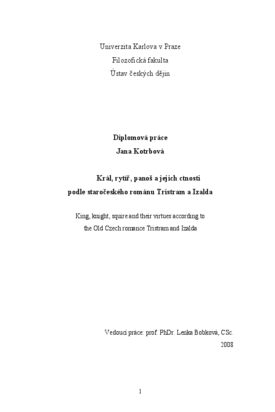Král, rytíř, panoš a jejich ctnosti podle staročeského románu Tristram a Izalda
King, knight, squire and their virtues according to the Old Czech romance Tristram and Izalda
diplomová práce (OBHÁJENO)

Zobrazit/
Trvalý odkaz
http://hdl.handle.net/20.500.11956/17413Identifikátory
SIS: 62138
Katalog UK: 990010351610106986
Kolekce
- Kvalifikační práce [24991]
Autor
Vedoucí práce
Oponent práce
Fantysová Matějková, Jana
Fakulta / součást
Filozofická fakulta
Obor
Historie - Sociologie
Katedra / ústav / klinika
Ústav českých dějin
Datum obhajoby
15. 9. 2008
Nakladatel
Univerzita Karlova, Filozofická fakultaJazyk
Čeština
Známka
Výborně
Práce se zabývá staročeským veršovaným románem Tristram a Izalda. Zkoumám nejprve žánr rytířských románů v kontextu české literatury 13. a 14. století. Zajímá mě pohled literární historie na tato díla, především hodnocení Tristrama a Izaldy. Věnuji se recepci tristanovské látky v českém prostředí, které se nejdříve seznámilo s německými verzemi tohoto eposu. Staročeský překlad ze 14. století vychází z tří německých pramenů, jež různě kombinuje. Pokouším se román využít jako pramen odrážející ideový svět české šlechty pozdního středověku. Z postav vyskytujících se v románu jsem zkonstruovala čtyři sociální skupiny (panovníci, rytíři a dvorští úředníci, urozené ženy, služebníci). Na vybraných ctnostech (věrnost, štědrost, moudrost, čest) a sociálních vztazích (přátelství, manželství, láska) sleduji, jakým způsobem jsou zobrazovány u jednotlivých sociálních skupin. Do každé sociální pozice jsou vkládána jiná očekávání. V připisování vlastností a preferovaného typu chování se projevuje jasná hierarchie. Centrální postavou je rytíř, k němuž se další skupiny vždy nějakým způsobem vztahují. Zdá se mi, že román svým zaměřením odpovídal především požadavkům vyšší šlechty a příslušníků dvora.
The thesis deals with an Old Czech novel in verse Tristram and Izalda. Initially, I examine the genre of chivalric novel in the context of Czech literature of the thirteenth and fourteenth century. I am interested in the view of literary history on these texts and primarily in the assessment of Tristram and Izalda. I pursue the reception of the Tristanian topic in the Czech environment, which has first been introduced to the German versions of this epic. The Old Czech translation from second half of 14th century gains from three German sources that are variously combined. I endeavour to use the novel as a source reflecting the ideological world of the Czech aristocracy of late mediaeval times. I have defined - on the basis of the characters present in the novel - four social groups: rulers, knights and court officials, noble women and servants. On the selected virtues - faithfulness, generosity, wisdom and honour - and social relationships - friendship, marriage and love - I observe the way of their depiction at individual social groups. Each social position carries different expectations. The attribution of characteristic features and the preferred type of behaviour reveal a clear hierarchy. The central character is the knight, to whom the other groups are always specifically related. In my opinion, the...
